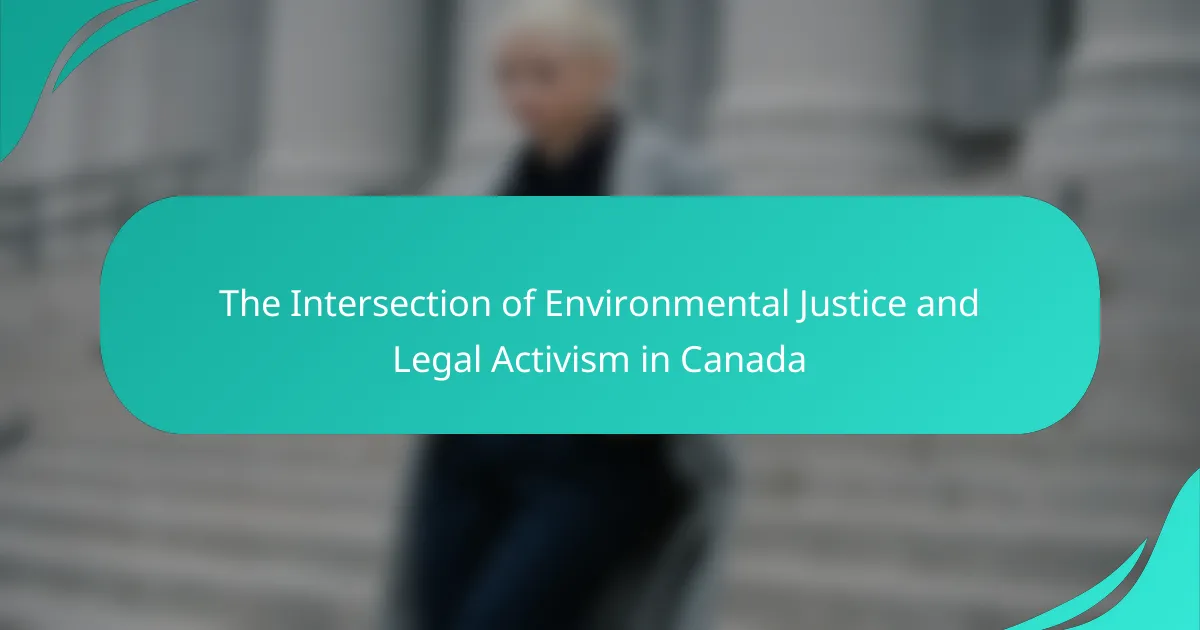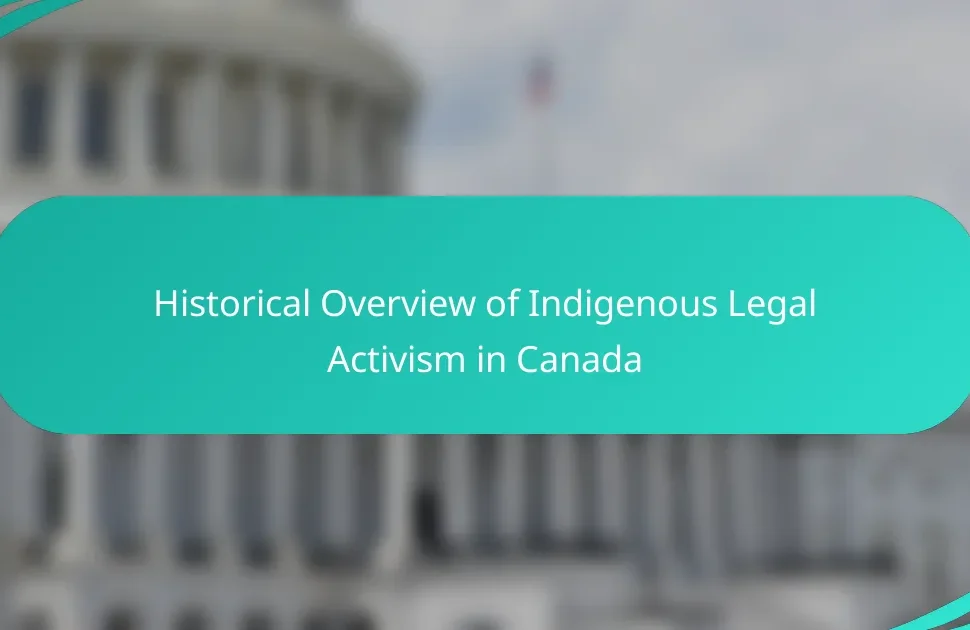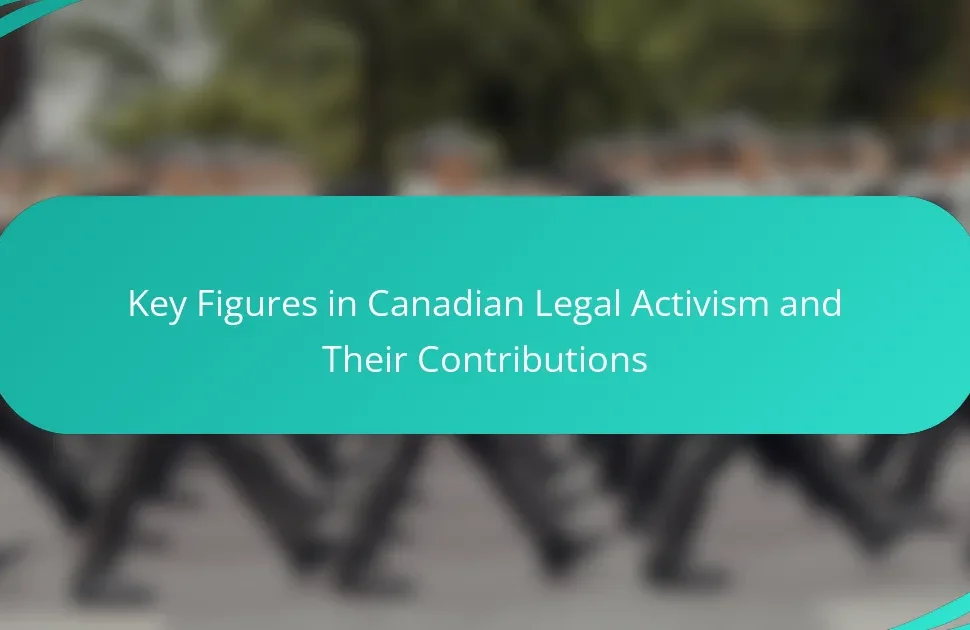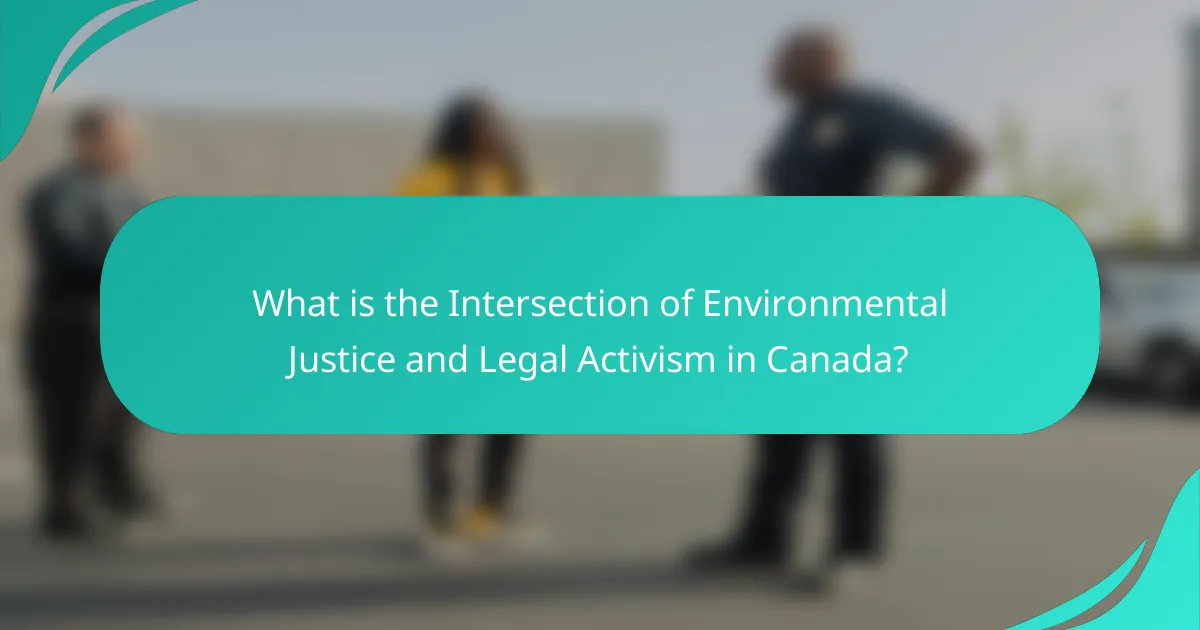
What is the Intersection of Environmental Justice and Legal Activism in Canada?
The intersection of environmental justice and legal activism in Canada involves the pursuit of equitable environmental protection through legal means. Environmental justice focuses on the fair distribution of environmental benefits and burdens across different communities. Legal activism serves as a tool to address environmental inequalities, often advocating for marginalized groups.
In Canada, Indigenous communities frequently lead legal actions to protect their lands from environmental harm. These actions highlight the disproportionate impact of environmental degradation on Indigenous populations. The landmark case of Tsilhqot’in Nation v. British Columbia (2014) affirmed Indigenous land rights, showcasing legal activism’s role in environmental justice.
Moreover, environmental organizations often engage in litigation to challenge government decisions that threaten ecosystems. For instance, the Ecojustice organization has taken legal action to enforce environmental laws and protect biodiversity. Such efforts illustrate the synergy between environmental justice and legal frameworks in Canada.
How do environmental justice and legal activism correlate in the Canadian context?
Environmental justice and legal activism in Canada are closely linked. Environmental justice addresses the disproportionate impact of environmental hazards on marginalized communities. Legal activism seeks to challenge and change laws that perpetuate these inequalities. In Canada, Indigenous communities often lead legal challenges against projects that threaten their land and health. For example, the Supreme Court of Canada case Tsilhqot’in Nation v. British Columbia recognized Indigenous land rights. This legal victory supports environmental justice by affirming Indigenous sovereignty over natural resources. Furthermore, organizations like Ecojustice advocate for legal reforms that promote environmental equity. These efforts highlight the synergy between legal activism and the pursuit of environmental justice in Canada.
What are the historical roots of environmental justice in Canada?
Environmental justice in Canada has historical roots that trace back to Indigenous activism and environmental movements. Indigenous peoples have long fought against environmental degradation affecting their lands and communities. The 1960s and 1970s saw a rise in awareness regarding the impacts of industrial projects on marginalized communities. Key events, such as the protest against the construction of the James Bay hydroelectric project, highlighted these issues. This activism laid the groundwork for the formal recognition of environmental justice. In the 1990s, the concept gained traction as communities sought equitable treatment in environmental decision-making. The 1999 report by the Royal Commission on Aboriginal Peoples emphasized the need for justice in environmental matters. These historical events illustrate the evolution of environmental justice as a response to systemic inequalities in Canada.
How has legal activism evolved in response to environmental issues in Canada?
Legal activism in Canada has evolved significantly in response to environmental issues over the past few decades. Initially, legal actions were primarily focused on regulatory compliance and the enforcement of existing environmental laws. As environmental awareness grew, activists began to challenge government policies and corporate practices more aggressively.
The rise of Indigenous rights has also influenced legal activism. Landmark cases, such as the 2014 Tsilhqot’in decision, recognized Indigenous land rights and their role in environmental stewardship. This has led to increased collaboration between Indigenous groups and environmental activists.
Moreover, the emergence of climate change as a pressing issue has shifted legal strategies. Activists now frequently use litigation to hold governments accountable for failing to meet climate commitments. For example, the 2019 case of Our Children’s Trust in Canada sought to compel the government to take stronger climate action.
The legal landscape has also seen the introduction of new laws aimed at enhancing environmental protection. The Canadian Environmental Protection Act has been amended to strengthen regulations on toxic substances, reflecting a growing recognition of environmental justice.
Overall, legal activism in Canada has transitioned from compliance-focused actions to a broader strategy that encompasses Indigenous rights, climate accountability, and proactive legislative changes. This evolution demonstrates a more integrated approach to addressing environmental issues through the legal system.
Why is the intersection of these two fields significant for Canadian communities?
The intersection of environmental justice and legal activism is significant for Canadian communities because it addresses systemic inequalities in environmental protection. This intersection empowers marginalized groups to advocate for their rights. Legal activism provides tools to challenge injustices faced by these communities. For instance, Indigenous groups often face disproportionate impacts from environmental degradation. Legal frameworks can support their claims for land and resource rights. Moreover, environmental justice initiatives promote sustainable practices that benefit all community members. Data shows that equitable environmental policies lead to healthier communities. Therefore, this intersection fosters resilience and equity in Canadian society.
What impact does environmental injustice have on marginalized communities in Canada?
Environmental injustice significantly harms marginalized communities in Canada. These communities often face higher exposure to pollution and environmental hazards. For instance, Indigenous populations frequently live near industrial sites. This proximity leads to health issues such as respiratory diseases and higher cancer rates. Access to clean water is also a critical issue, with many Indigenous communities under long-term boil water advisories. Additionally, marginalized groups often lack representation in environmental decision-making processes. This exclusion perpetuates cycles of disadvantage and limits their ability to advocate for their rights. Studies show that environmental policies frequently overlook the needs of these communities. Thus, environmental injustice exacerbates existing social inequalities in Canada.
How does legal activism address these environmental injustices?
Legal activism addresses environmental injustices by using the law to challenge harmful practices and advocate for marginalized communities. It empowers affected individuals to seek redress through litigation. Legal activists often file lawsuits against corporations or governments that violate environmental regulations. This legal action can lead to stricter enforcement of environmental laws. For instance, cases may result in the cleanup of polluted sites. Legal activism also raises public awareness about environmental issues. It mobilizes community support and influences policy changes. In Canada, successful legal actions have established precedents that protect vulnerable populations. These efforts contribute to a more equitable distribution of environmental benefits and burdens.
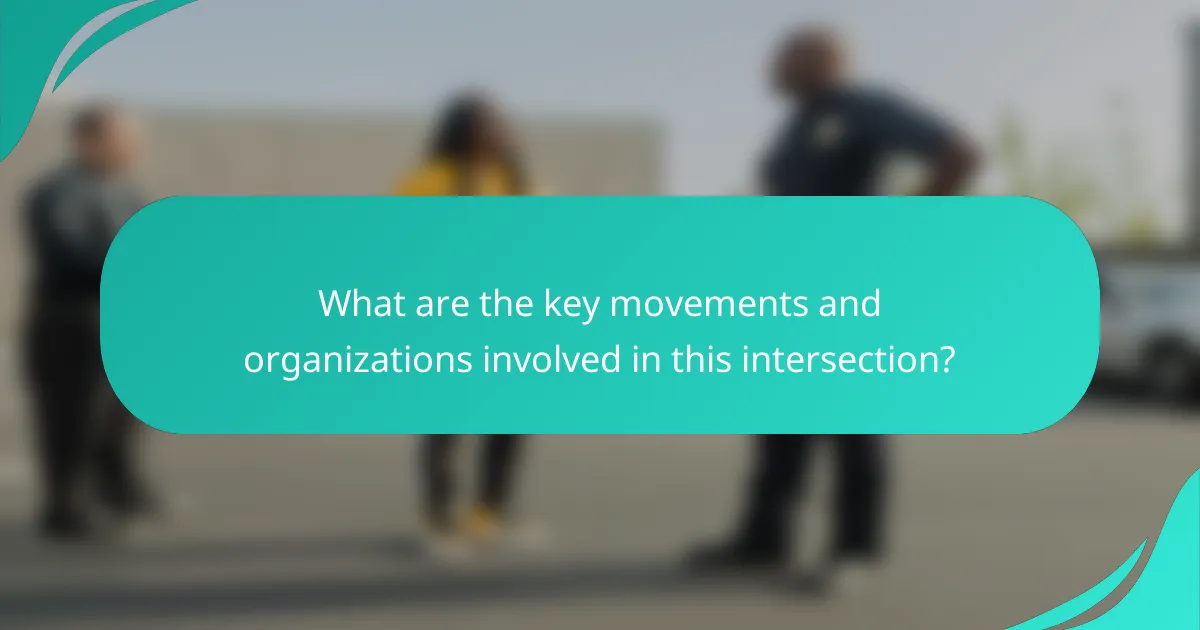
What are the key movements and organizations involved in this intersection?
Key movements and organizations involved in the intersection of environmental justice and legal activism in Canada include the Indigenous Environmental Network and Ecojustice. The Indigenous Environmental Network focuses on Indigenous rights and environmental protection. Ecojustice is a prominent environmental law organization that advocates for legal action on environmental issues. The David Suzuki Foundation also plays a significant role in promoting sustainable practices and policy changes. Additionally, the Canadian Environmental Law Association works to provide legal support for environmental justice initiatives. These organizations collaborate on various campaigns and legal challenges to address environmental injustices across Canada. Their efforts highlight the critical link between legal frameworks and environmental activism in promoting social equity.
Which grassroots movements are leading the charge for environmental justice in Canada?
The grassroots movements leading the charge for environmental justice in Canada include the Indigenous Environmental Network and the Climate Justice Edmonton. The Indigenous Environmental Network focuses on the rights of Indigenous peoples and environmental protection. They advocate against resource extraction projects that threaten land and water. Climate Justice Edmonton mobilizes community action against climate change and promotes sustainable practices. They emphasize the need for equity in climate policies. Other notable movements include the Sierra Club Canada and the Council of Canadians, which address environmental issues through grassroots activism. These organizations work to raise awareness and influence policy changes in favor of environmental justice.
What strategies do these movements employ to promote legal activism?
Environmental justice movements in Canada employ several strategies to promote legal activism. They utilize grassroots organizing to mobilize community support and raise awareness. Legal education initiatives empower individuals with knowledge about their rights and the legal system. Collaborations with environmental organizations amplify their reach and resources. Strategic litigation challenges unjust laws and policies in court. Public campaigns highlight environmental issues, drawing media attention and public support. They also engage in policy advocacy to influence lawmakers and promote legislative changes. These strategies collectively strengthen the movement’s impact on legal activism in Canada.
How do these movements collaborate with legal organizations?
Environmental justice movements collaborate with legal organizations through strategic partnerships. These collaborations often focus on litigation, advocacy, and policy reform. Legal organizations provide expertise in navigating the legal system. They help movements understand environmental laws and regulations. Joint efforts aim to address issues like pollution and land rights. Collaborative actions include filing lawsuits against corporations and governments. These legal challenges seek to enforce environmental protections. Successful cases can lead to significant policy changes and increased awareness. Such collaborations amplify the voices of marginalized communities affected by environmental issues.
What role do Indigenous communities play in environmental justice and legal activism?
Indigenous communities play a crucial role in environmental justice and legal activism. They advocate for the protection of their lands and resources. Their traditional knowledge informs sustainable practices and conservation efforts. Indigenous legal frameworks challenge environmental injustices in courts. They often lead protests against resource extraction that threatens their territories. Their activism raises awareness about climate change impacts on marginalized communities. Indigenous rights are recognized in international law, strengthening their legal claims. Collaborative efforts with environmental organizations amplify their voices in policy discussions.
How do Indigenous rights intersect with environmental justice issues in Canada?
Indigenous rights and environmental justice issues in Canada are closely linked. Indigenous communities often rely on their ancestral lands for cultural, spiritual, and economic sustenance. Environmental degradation disproportionately affects these communities, undermining their rights and livelihoods. The United Nations Declaration on the Rights of Indigenous Peoples (UNDRIP) emphasizes the need for free, prior, and informed consent regarding projects impacting Indigenous lands. Canadian courts have recognized land rights through landmark cases like the Calder case in 1973 and the Tsilhqot’in Nation case in 2014. These rulings affirm Indigenous sovereignty and the necessity of considering their rights in environmental decision-making. Environmental justice movements often advocate for the protection of Indigenous rights as a means to address broader ecological issues. This intersection highlights the importance of integrating Indigenous knowledge and perspectives in environmental policies to achieve equitable outcomes.
What legal frameworks support Indigenous activism in environmental matters?
Legal frameworks supporting Indigenous activism in environmental matters include treaties, constitutional provisions, and international agreements. Treaties often recognize Indigenous rights to land and resources. The Constitution Act of 1982 affirms Indigenous rights in Canada. The United Nations Declaration on the Rights of Indigenous Peoples (UNDRIP) emphasizes the right to participate in environmental decision-making. Additionally, the Canadian Environmental Assessment Act requires consultation with Indigenous communities. These frameworks provide a legal basis for Indigenous groups to advocate for environmental protection. They empower Indigenous voices in discussions about land use and resource management.

What challenges and opportunities exist at this intersection?
Challenges at the intersection of environmental justice and legal activism in Canada include systemic inequalities and lack of access to legal resources. Marginalized communities often face barriers in engaging with legal processes. These barriers can lead to underrepresentation in environmental decision-making. Additionally, there is often insufficient legal framework to address environmental harms effectively.
Opportunities exist through increased public awareness and advocacy. Legal activism can mobilize communities to assert their rights. Collaborative efforts between NGOs and affected communities can amplify voices. Moreover, recent legal precedents have strengthened the ability to challenge environmental injustices. These developments create pathways for meaningful change in policy and practice.
What are the primary challenges faced by legal activists in promoting environmental justice?
Legal activists face several primary challenges in promoting environmental justice. One major challenge is the lack of funding and resources. Many legal activists operate on limited budgets, which restricts their ability to take on cases. Additionally, there is often insufficient legal framework to support environmental justice claims. This can lead to difficulties in proving cases in court. Another challenge is public awareness and engagement. Many communities are unaware of their rights regarding environmental issues. Furthermore, legal activists may encounter resistance from powerful industries and government entities. These groups often prioritize economic interests over environmental concerns. Lastly, legal activists must navigate complex regulatory environments. This can make it difficult to implement effective legal strategies.
How do systemic barriers hinder progress in legal activism?
Systemic barriers hinder progress in legal activism by creating obstacles that limit access to justice. These barriers include socio-economic disparities, which affect the ability of marginalized communities to engage in legal processes. Additionally, institutional discrimination can lead to unequal treatment within the legal system. For example, underfunded legal aid services restrict support for those pursuing environmental justice cases. Furthermore, bureaucratic red tape can delay or obstruct legal actions, making it difficult for activists to achieve their goals. Studies show that these systemic issues disproportionately impact Indigenous and low-income communities in Canada, further complicating their fight for environmental justice.
What are the implications of climate change for environmental justice initiatives?
Climate change significantly impacts environmental justice initiatives by exacerbating existing inequalities. Vulnerable communities often face the brunt of climate-related disasters. These groups typically have fewer resources to adapt or recover from such events. For example, low-income neighborhoods may lack infrastructure to withstand floods or heatwaves. This creates a cycle of disadvantage that hinders their ability to advocate for policy changes. Moreover, climate change can lead to increased pollution in marginalized areas. This further compounds health disparities among these communities. Research indicates that environmental injustices are likely to worsen as climate change progresses. Therefore, addressing climate change is crucial for achieving equitable environmental justice.
What opportunities can be harnessed to enhance legal activism for environmental justice?
Legal activism for environmental justice can be enhanced through strategic partnerships, community engagement, and policy reform. Collaborative efforts with NGOs and grassroots organizations can amplify voices and resources. Engaging local communities fosters awareness and mobilizes support for environmental issues. Utilizing technology can streamline communication and advocacy efforts. Access to legal education empowers individuals to understand their rights. Legislative advocacy can lead to stronger environmental protections. Courts can serve as platforms for challenging injustices and holding corporations accountable. Historical cases, such as the 2019 Supreme Court decision on environmental assessments, demonstrate the impact of legal activism in shaping policy.
How can technology and social media amplify legal activism efforts?
Technology and social media amplify legal activism efforts by enhancing communication and mobilization. They provide platforms for activists to share information rapidly. Social media enables real-time updates on legal issues and events. This immediacy fosters a sense of urgency and community among supporters. Technology also facilitates the organization of protests and campaigns through event planning tools. Online petitions can gather widespread support quickly, demonstrating public backing for legal causes. Additionally, digital storytelling can highlight personal narratives that resonate emotionally with audiences. Research shows that social media campaigns can significantly increase public engagement and awareness, leading to greater pressure on legal systems.
What role do partnerships between organizations play in advancing environmental justice?
Partnerships between organizations play a crucial role in advancing environmental justice. They foster collaboration and resource sharing among diverse stakeholders. This collaboration enhances advocacy efforts for marginalized communities. Organizations can leverage each other’s strengths and expertise. For example, legal groups can provide legal support while grassroots organizations mobilize community engagement. Research indicates that collaborative efforts lead to more effective policy changes. A study by the Environmental Law Institute highlights successful partnerships in addressing environmental inequities. These partnerships amplify voices that are often overlooked in environmental decision-making. Overall, they create a united front for promoting equitable environmental policies.
What best practices can be adopted for effective legal activism in environmental justice?
Effective legal activism in environmental justice can be achieved through several best practices. First, building strong coalitions among diverse stakeholders enhances advocacy efforts. Collaboration with local communities ensures their voices are heard in legal processes. Second, utilizing data and scientific evidence strengthens legal arguments. Courts respond favorably to well-documented environmental impacts. Third, engaging in public education raises awareness about environmental justice issues. Informed citizens are more likely to support legal initiatives. Fourth, pursuing strategic litigation can create precedents that benefit broader movements. Successful cases can inspire similar actions elsewhere. Fifth, leveraging social media amplifies outreach and mobilizes support quickly. Online platforms can rally public opinion for legal causes. Lastly, continuous monitoring of environmental policies ensures accountability and fosters long-term change. These practices collectively enhance the effectiveness of legal activism in promoting environmental justice.
How can activists effectively engage with policymakers on environmental issues?
Activists can effectively engage with policymakers on environmental issues by building strong relationships and presenting clear, evidence-based arguments. Establishing connections with policymakers fosters trust and understanding. Engaging in regular communication ensures that activists remain informed about legislative processes. Providing concise, fact-driven information on environmental impacts can influence policy decisions. Utilizing case studies and statistical data strengthens the argument for action. Collaborating with local communities amplifies the voice of affected populations. Mobilizing public support through campaigns can create pressure for policy change. Active participation in public consultations allows activists to directly influence policymaking.
What strategies can enhance community involvement in legal activism efforts?
Engaging communities in legal activism efforts can be enhanced through education, collaboration, and mobilization. Education increases awareness about legal rights and environmental issues. Workshops and seminars can help community members understand legal processes. Collaboration with local organizations fosters a united front for activism. Partnerships can amplify resources and reach. Mobilization through social media can gather support quickly. Campaigns that highlight local issues resonate with community members. Creating spaces for dialogue encourages participation and feedback. These strategies collectively strengthen community involvement in legal activism.
The main entity of the article is the intersection of environmental justice and legal activism in Canada. This overview outlines how these two fields work together to address systemic inequalities in environmental protection, particularly for marginalized communities, including Indigenous populations. The article explores historical roots, key movements, and organizations involved in this intersection, as well as the evolution of legal activism in response to environmental issues. It highlights the challenges and opportunities faced by activists, the impact of climate change on environmental justice initiatives, and the importance of collaboration between grassroots movements and legal organizations. Additionally, it discusses strategies for enhancing community involvement and effectively engaging policymakers on environmental issues.
